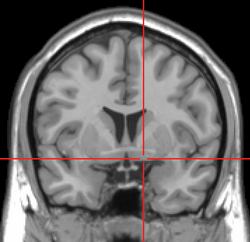Substantia innominata
Appearance
| Substantia innominata | |
|---|---|
 Coronal MRI slice with cross-hairs indicating location of the substantia innominata | |
| Identifiers | |
| MeSH | D013377 |
| NeuroNames | 274 |
| NeuroLex ID | birnlex_915 |
| TA98 | A14.1.09.426 |
| TA2 | 5544 |
| FMA | 61885 |
| Anatomical terms of neuroanatomy | |
The substantia innominata (literally "unnamed substance") of Meynert is a stratum in the human brain consisting partly of gray and partly of white substance, which lies below the anterior part of the thalamus and lentiform nucleus. The gross anatomical structure is called the anterior perforated substance because, to the naked eye, it appears to be perforated by many holes (which are actually blood vessels). It is part of the basal forebrain and includes the nucleus basalis.
Layers

It consists of three layers, superior, middle, and inferior.
- The superior layer is named the ansa lentiformis, and its fibers, derived from the medullary lamina of the lentiform nucleus, pass medially to end in the thalamus and subthalamic region, while others are said to end in the tegmentum and red nucleus.
- The middle layer consists of nerve cells and nerve fibers; fibers enter it from the parietal lobe through the external capsule, while others are said to connect it with the medial longitudinal fasciculus.
- The inferior layer forms the main part of the inferior stalk of the thalamus, and connects this body with the temporal lobe and the insula.
References
![]() This article incorporates text in the public domain from page 837 of the 20th edition of Gray's Anatomy (1918)
This article incorporates text in the public domain from page 837 of the 20th edition of Gray's Anatomy (1918)
